6 March 1340 - 3 February 1399
John of Gaunt, Shakespeare's 'time honoured Lancaster', was the fourth but third surviving son of King Edward III and Phillipa of Hainault. Gaunt is an anglicized version of his birthplace of Ghent.
John of Gaunt, Duke of Lancaster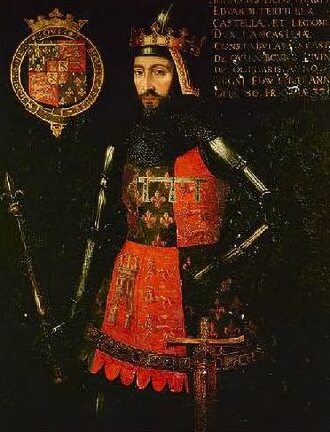
In 1350, at the age of ten, John was present at the naval Battle of Winchelsea, where, it is said, his life was saved by Henry of Grosmont, Duke of Lancaster, who attacked the large Spanish ship which engaged the ship that John and his elder brother Edward, the Prince of Wales were sailing in. Described as tall and well-built by contemporaries, John's first child was an illegitimate daughter, Blanche (1359-1388/89). Blanche was the daughter of John's mistress Marie de St. Hilaire of Hainaut was a lady-in-waiting to his mother, Queen Philippa.
Edward III arranged John's marriage to the wealthy heiress Blanche of Lancaster on 19 May 1359, at Reading Abbey in Berkshire. Blanche of Lancaster, the daughter of Henry of Grosmont, 1st Duke of Lancaster and his wife Isabel de Beaumont, was John's third cousin, both were great great grandchildren of King Henry III. Blanche descended from Henry's younger son, Edmund Crouchback, Earl of Lancaster. The whole royal family attended the wedding, Edward III presented the fourteen year old Blanche with expensive gifts of jewellery.
Blanche of Lancaster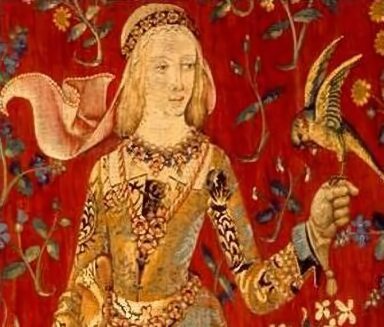
On the death of Henry of Grosmont in 1361, John inherited half his lands and the title Earl of Lancaster, he also became the 14th Baron of Halton and 11th Lord of Bowland. John acquired the rest of Henry's great estates when Blanche's sister, Maud, Countess of Leicester, died on 10 April 1362. He received the title Duke of Lancaster from his father the king on 13th November 1362.
The marriage is widely believed to have been a happy one, Blanche, a fair haired, beautiful and gracious woman, was described by the chronicler Jean Froissart as "jone et jolie" ("young and pretty"). Geoffrey Chaucer described "White", the central figure in his Book of the Duchess, which is believed to have been inspired by Blanche, in such terms as "rody, fresh, and lyvely hewed", her neck as "whyt, smothe, streght, and flat", and her throat as "a round tour of yvoire": she was "bothe fair and bright", and Nature's "cheef patron (pattern) of beautee".
The marriage produced seven children, a daughter, Philippa of Lancaster (31 March 1360 - 19 July 1415), who became the Queen consort of John I of Portugal, a son John (c.1362/1364), who died in infancy, Elizabeth of Lancaster, (21 February 1364 - 24 November 1426), who married firstly John Hastings, 3rd Earl of Pembroke, secondly to John Holland, 1st Duke of Exeter and finally to John Cornwall, 1st Baron Fanhope. Two further sons, Edward (1365 - 1365) and John (1366) also died in infancy, the only surviving son of the marriage Henry of Bolingbroke, was born on 3 April 1367 and later became King Henry IV after he overthrew his cousin, Richard II, and finally a daughter Isabella, (b.1368) who died young. Blanche of Lancaster died of bubonic plague at the age of 23, at Tutbury Castle, Staffordshire, on 12 September 1368 while John was abroad. She was buried at the old St. Paul's Cathedral in London, John was reported to have been grief-stricken.
Phillipa of Lancaster, Queen of Portugal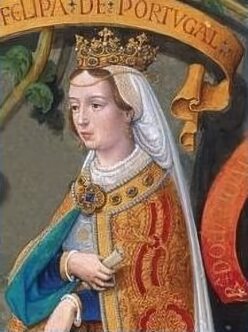
John campaigned with his elder brother Edward of Woodstock, known as the Black Prince and participated in many of the battles of the Hundred Years War and in aid of his ally Pedro the Cruel of Castile. Following the death of Edward, the Black Prince, John of Gaunt gave protection to the religious reformer John Wycliffe, possibly to counteract the growing power of the Roman Catholic Church.
John's ascendancy to political power coincided with widespread resentment of his influence in England. English forces had experienced setbacks in the Hundred Years' War, Edward III's rule was becoming unpopular due to high taxation and his affair with Alice Perrers, political opinion closely associated John with the failing government of the 1370s.
Edward III died of a stroke at Sheen, a shadow of his former self, in 1377 and was succeeded by his ten-year-old grandson Richard II. John was the virtual ruler of England during the young king's minority but made unwise decisions on taxation which culminated in the Peasants' Revolt in 1381, Gaunt was blamed for the introduction of the unpopular poll tax, he was away from London at the time of the revolt and thus avoided the wrath of the rebels, however, his Palace of Savoy, considered the grandest nobleman's townhouse of medieval London, was destroyed during the rebellion. What the peasants could not smash or burn was thrown into the river.
Elizabeth of Lancaster, Duchess of Exeter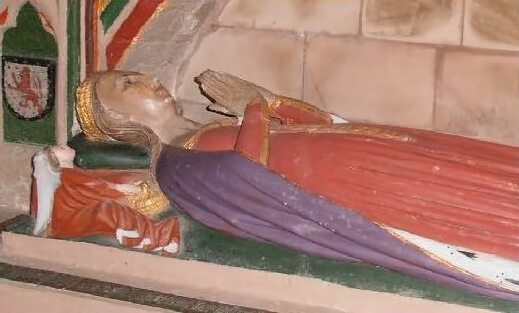
On 21 September 1371, John took Constanza of Castille, the daughter of Pedro the Cruel of Castille and Leon, as his second wife. They married at Roquefort, near Bordeaux, in Guienne, on 21 September 1371. It was a loveless marriage, but nevertheless produced two children, a daughter, Catherine (1372-1418) and a son John (1374-1375), who died in infancy.
Constance's father, King Pedro of Castile, was murdered by his half-brother, Henry of Castile, who usurped his throne, Constanza, Pedro's eldest daughter, was his rightful heiress. Following his marriage to Constanza, John's fate was inextricably interwoven with that of the Iberian peninsula. Under Spanish law, the husband of a female heir to the throne was the rightful king, John impaled his arms with those of Castille and in 1386, he left England in an unsuccessful attempt to claim the Castillian throne in right of his wife. He and Constanza's daughter, Catherine of Lancaster was later married to the future Henry III of Castille, son of King John I of Castile, thereby uniting these two rival claims. In return Constanza, Duchess of Lancaster agreed to renounce all claims to the Castilian throne.
In John's absence, Richard II's mishandling of affairs brought England to the brink of civil war. On his return in 1389, John persuaded Richard and the Lords Appellant led by John's younger brother, Thomas of Woodstock, Duke of Gloucester, to compromise, which ushered in a period of relative stability. Four months after his return to England, in March 1390, Richard II invested John with the Duchy of Aquitaine.
Constanza of Castile died at Leicester Castle on 24 March 1394 and was buried at Newark Abbey, Leicester. During their marriage, John had fathered four illegitimate children by his mistress, Katherine Swynford, daughter of Sir Paine Roet and widow of Hugh Swynford, a knight. Katherine had joined the household of John of Gaunt as governess to his eldest daughters Philippa and Elizabeth of Lancaster. John had stood as godfather to Katherine's daughter, Blanche Swynford and his first wife Blanche of Lancaster had Katherine's daughter Blanche placed within her own daughters' chambers and afforded the same luxuries as them. Katherine's sister Philippa de Roet, who was a lady of Queen Philippa's household, married the poet Geoffrey Chaucer. John married Katherine in 1396 at Lincoln Cathedral, shortly after Constanza's death.
Their children, given the surname Beaufort, derived from John's lordship of Beaufort in Champagne, in France, were legitimized by Richard II and the Church, but barred from inheriting the throne. The Beauforts were to play an important part in fifteenth-century politics, John Beaufort (1373-1410) was created, 1st Earl of Somerset, Henry Beaufort, Cardinal, (1375-1447) Thomas Beaufort, 1st Duke of Exeter (1377-1426) and a daughter Joan Beaufort, (1379-1440) married Ralph Neville and became Countess of Westmorland and became the ancestress of the Yorkist kings Edward IV and Richard III.
John Beaufort, Earl of Somerset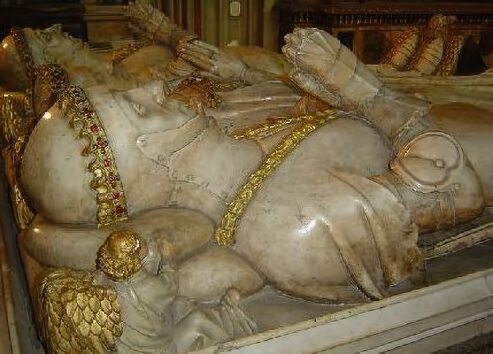
Richard struck back against the Lords Appellant in 1397, John's younger brother, Thomas, Duke of Gloucester was imprisoned in Calais to await trial for treason. Thomas was later murdered on his nephew Richard's orders. In 1398 Richard II exiled John's eldest son Henry of Bolingbroke.
John of Gaunt died at Leicester Castle on February 3rd, 1399, at the age of fifty-eight, he was buried beside his first wife, Blanche of Lancaster, in the choir of St Paul's Cathedral. Their two alabaster effigies had joined hands. Two days after Gaunt's funeral, Richard made Bolingbroke's banishment perpetual, disinherited his cousin and seized Gaunt's vast estates for the Crown.
On the death of his father in 1399, Henry landed at Ravenspur claiming he came to safeguard his inheritance but came to take the throne from the cousin he now thoroughly detested. Richard met Henry's representatives at Conway Castle and was informed that if he restored Henry's estates and surrendered certain councillors for trial, he could remain in power. He agreed but was betrayed and instead of being returned to power found himself the inhabitant of a dungeon in the Tower. A Parliament was called at the end of September, at which Bolingbroke claimed the throne as Henry IV. Richard was declared a tyrant and deposed. He was taken up to Pontefract Castle, in Yorkshire and there it is certain, he met his end around the second week in February 1400.
Katherine Swynford, known as the dowager Duchess of Lancaster after Gaunt's death, survived him by four years, she died on 10 May 1403, during the reign of Henry IV. She was buried in the sanctuary of Lincoln Cathedral, near her daughter Joan Beaufort.
The direct line of the House of Lancaster became extinct with the deaths of Henry VI and his son, Edward Prince of Wales in 1471. John Beaufort's, granddaughter, Margaret Beaufort, had a son, Henry Tudor, who later claimed the throne from the House of York and was crowned Henry VII, the first monarch of the Tudor dynasty.
Lionel of Antwerp PreviousNext Thomas of Woodstock
